
|
|
Vasudeva was succeeded by Kanishka II, probably around the year 225 CE or soon thereafter, and he reigned for approximately 20 years. The empire was already under
attack from the Sasanians in the northwest, and it appears that Kanishka II lost some ground in this struggle. Nevertheless, he continued to issue coins in the region, so it is
not clear how much territory he lost and exactly when he did so. Perhaps the area north of the Hindu Kush was lost but the area south of the mountains was retained.
Attributing coins to Kanishka II is not easy. Most coins come without a clear and complete circular legend, so we must rely on the few examples that do have readable
legends. The copper coinage is particularly difficult because the king's name is never on the flan ... we must rely on other clues. One interesting aspect of this coinage is that,
while Kanishka the Great's name was always presented in the genitive case as KANηþKI, Kanishka II's name is always presented in the nominative as
KANηþKO.
|
 |
Gold Coinage |
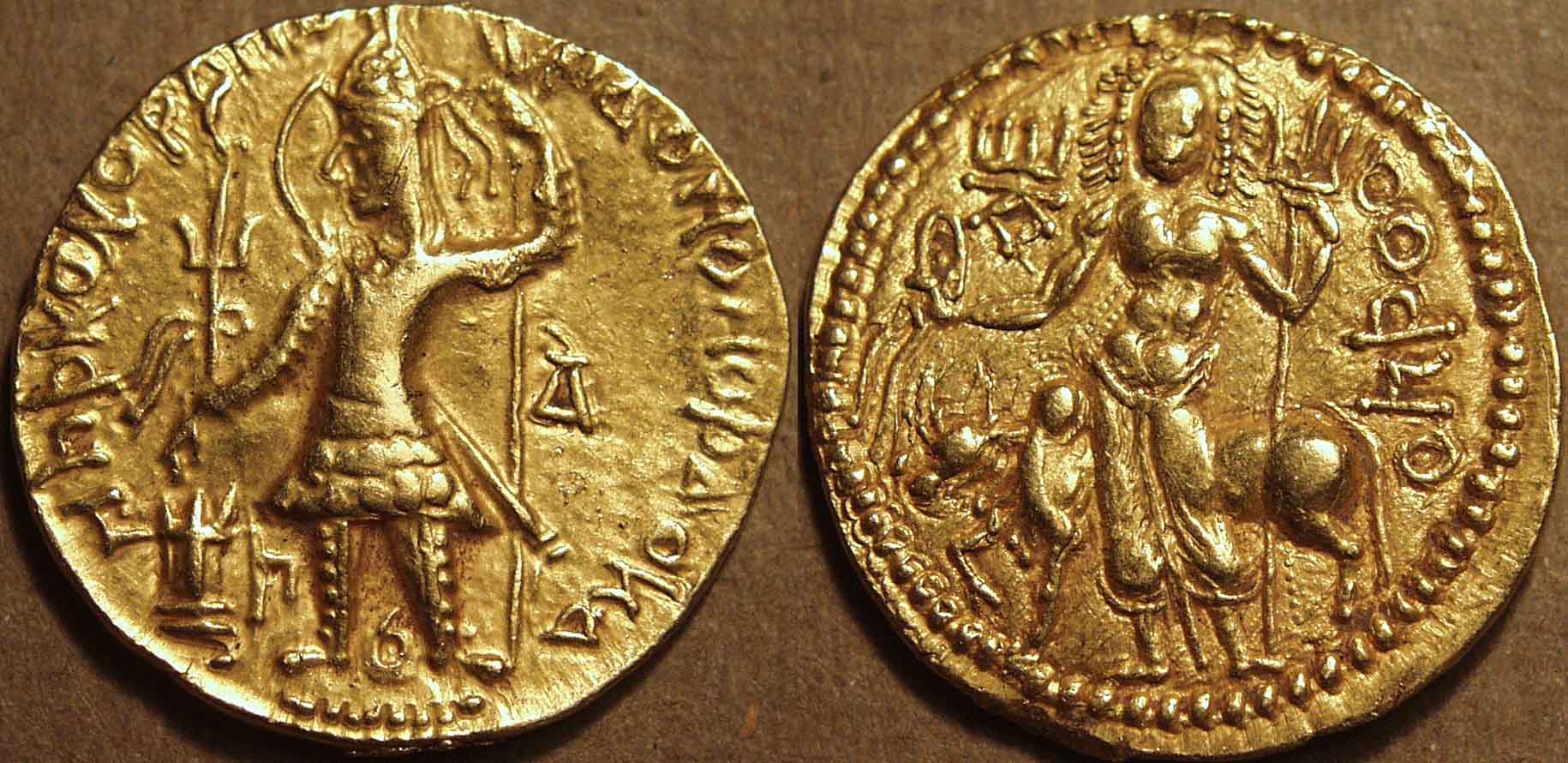
|
Gold dinar, c. 227-247 CE
Weight: 7.89 gm., Diam: 22-23 mm., Die axis: 12 o'clock
Crowned, diademed king standing facing, holding trident and sacrificing at altar at left,
second trident above altar, Bactrian legend around: þAONANOþAO KA ... NηþKO KOþANO
additional Brahmi letters: vi right, tha between legs, Kharoshthi pa left /
Two-armed Shiva standing facing, holding trident and diadem, Bull Nandi left behind,
Bactrian legend right: OηþO and additional tha above, tamgha at left
Göbl --- |
 |
This coin clearly follows the long-haired types of Vasudeva I. In all respects, it looks like Göbl 554, which Göbl
attributed to Vasishka. The photo in Göbl is not clear enough to see if the legend on his coin indeed reads Vasishka ... this one clearly names Kanishka. I have previously
published this type and explored its implications in the ONS Newsletter 172. |

|
Gold dinar, c. 227-247 CE
Weight: 7.71 gm., Diam: 22 mm., Die axis: 12 o'clock
Crowned, diademed king standing facing, holding standard and sacrificing at altar at left,
second trident above altar, Bactrian legend around: þAONANOþAO KA ... N ... ηþKO KOþANO
additional Brahmi letter: vi right /
Goddess of plenty Ardochsho enthroned facing, holding diadem and cornucopia,
Bactrian legend right: APΔOXþO Kharoshthi ru under throne, tamgha at left
Göbl 544 |
 |
Here Kanishka II reintroduces the goddess Ardochsho, who was frequently seen on coins of Kanishka and Huvishka,
but never on those of Vasudeva. Although this specimen is damaged around the face of the king, it is a prize for the collector because of its clear legend. Notice that on the
Ardochsho-reverse types the king is no longer shown holding a trident but a ribboned standard. But the trident above the altar is retained. |
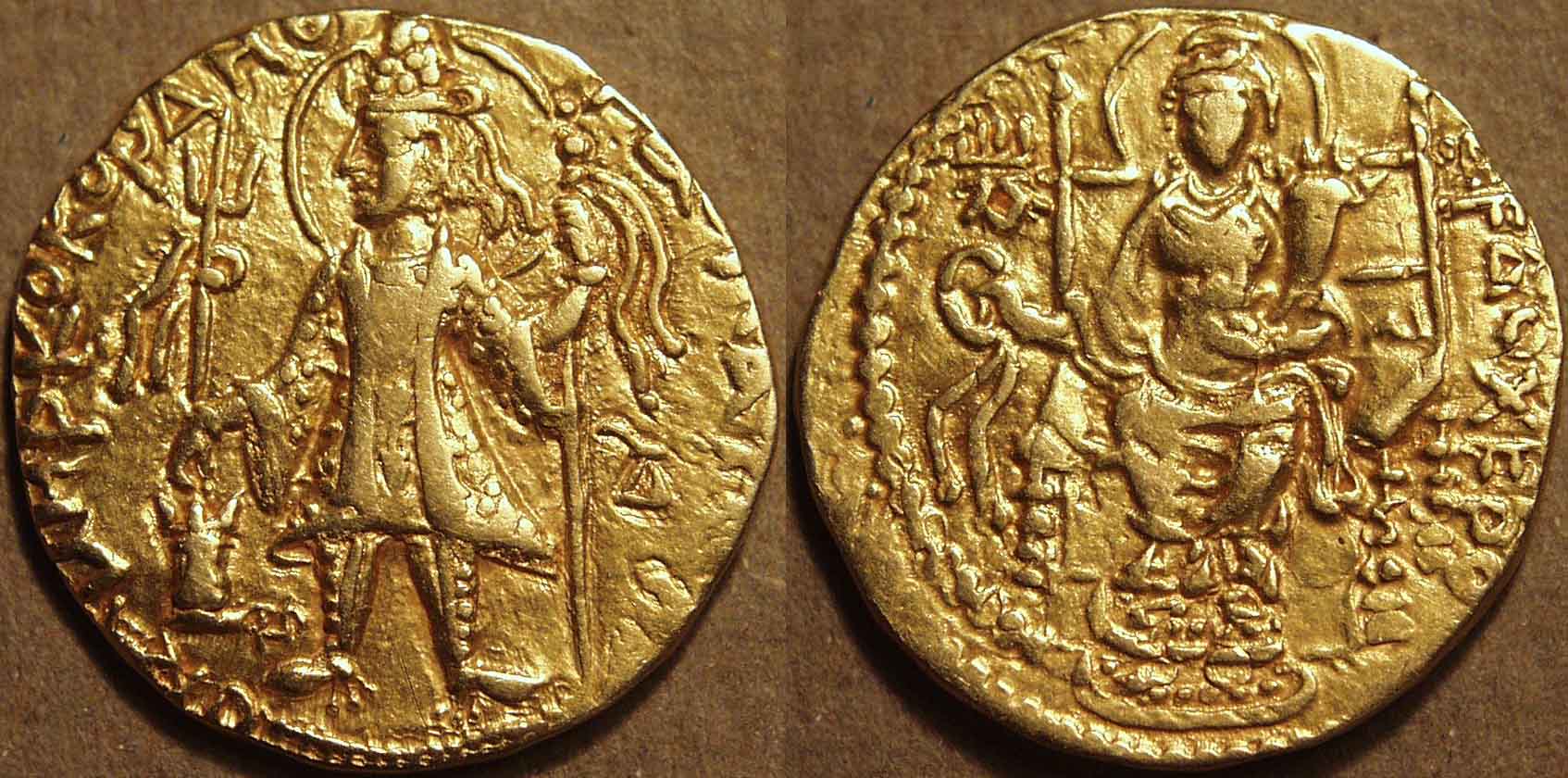
|
Gold dinar, c. 227-247 CE
Weight: 7.77 gm., Diam: 21 mm., Die axis: 12 o'clock
Crowned, diademed king standing facing, holding standard and sacrificing at altar at left,
second trident above altar, Bactrian legend around: þAONANOþA ... O KANηþKO KOþANO
additional Brahmi letter: vi right, ha at left /
Goddess of plenty Ardochsho enthroned facing, holding diadem and cornucopia,
Bactrian legend right: APΔOXþO, Brahmi la at right, tamgha at left
Göbl 541 |
 |
The legend on this coin has a very unusual arrangement, in that it breaks after þAONANOþA, with the remainder
appearing to the left. The normal break is at þAONANOþAO KA ... |
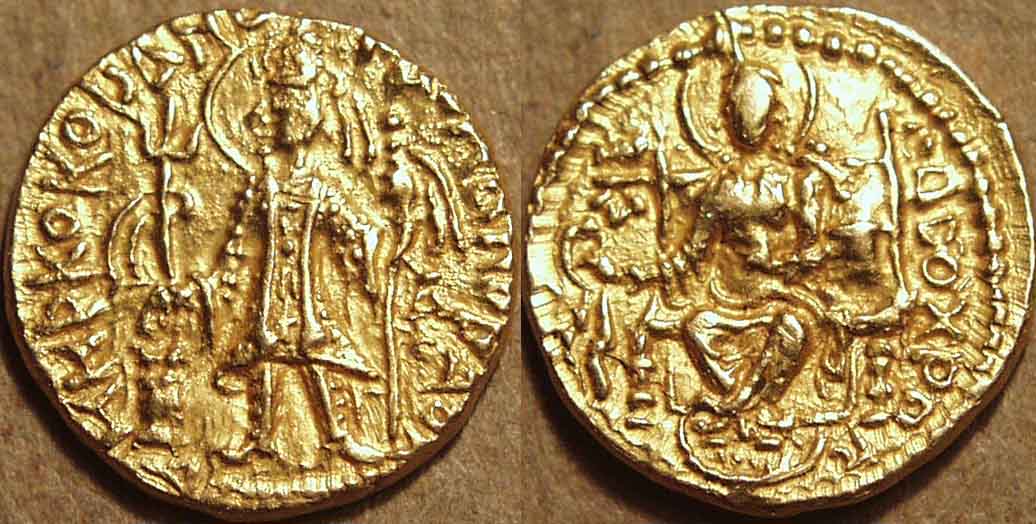
|
Gold quarter dinar, c. 227-247 CE
Weight: 1.97 gm., Diam: 13 mm., Die axis: 12 o'clock
Crowned, diademed king standing facing, holding standard and sacrificing at altar at left,
second trident above altar, Bactrian legend around: þAONANOþAO KA ... N ... ηþKO KOþANO
additional Brahmi letter: vi right /
Goddess of plenty Ardochsho enthroned facing, holding diadem and cornucopia,
Bactrian legend right: APΔOXþO, tamgha at left
Göbl 543 |
 |
Kanishka II's quarter dinars are extremely rare. |

|
Gold dinar, c. 227-247 CE
Weight: 7.81 gm., Diam: 20-21 mm., Die axis: 12 o'clock
Crowned, diademed king standing facing, holding trident and sacrificing at altar at left,
second trident above altar, Bactrian legend around: þAONANOþAO KA ... NηþKO KOþANO
additional Brahmi letters: pri right, gho or yo between legs, ga left /
Two-armed, three-headed Shiva standing facing, holding trident and diadem, Bull Nandi left behind,
Bactrian legend right: OηþO, tamgha at left
Göbl 635.7 |
 |
Although Göbl did publish a specimen of this coin type (635.7), he apparently didn't nnotice that it differed from other
examples of his type 635 in that it shows Shiva with three heads. The coin also carries what appears to be a Brahmi pri in the right field, echoing a coin of Vasudeva that
also carried that letter. |

|
Gold dinar, c. 227-247 CE
Weight: 7.82 gm., Diam: 20-21 mm., Die axis: 12 o'clock
Crowned, diademed king standing facing, holding trident and sacrificing at altar at left,
second trident above altar, Bactrian legend around: þAONANOþAO KA ... N ... ηþKO KOþANO
additional Brahmi letters: ha ra right, gho or yo between legs, ga left /
Two-armed Shiva standing facing, holding trident and diadem, Bull Nandi left behind,
Bactrian legend right: OηþO, tamgha at left
Göbl 634 var |
 |
This coin has an unusual cursive script and also carries a Brahmi ha ra in the right field. |
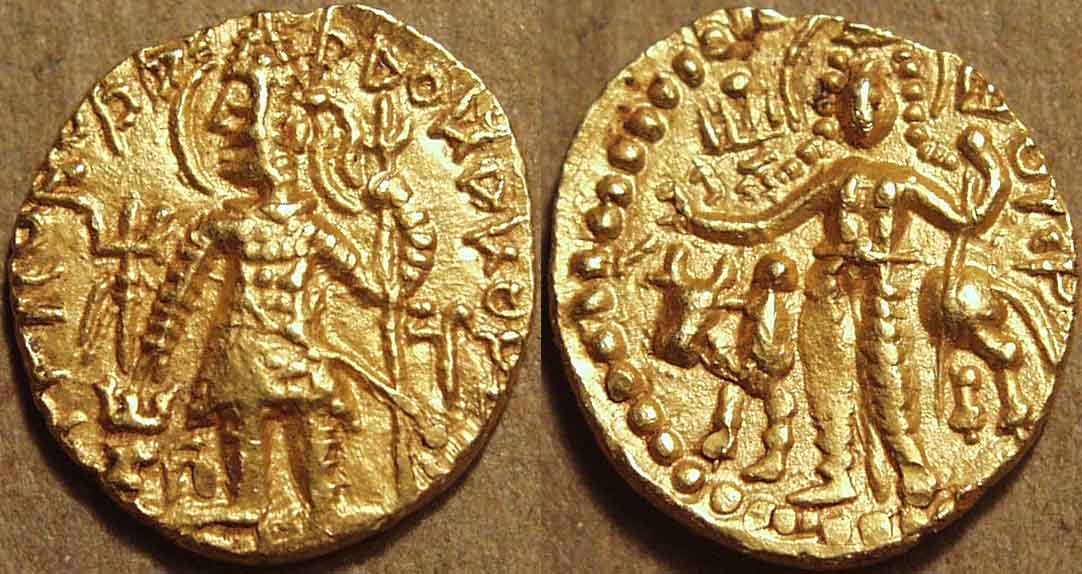
|
Gold quarter dinar, c. 227-247 CE
Weight: 2.01 gm., Diam: 13-14 mm., Die axis: 12 o'clock
Crowned, diademed king standing facing, holding trident and sacrificing at altar at left,
second trident above altar, Bactrian legend around: þAONANOþAO KA ... N ... ηþKO KOþANO
additional Brahmi letters: ha ra right, gho or yo between legs, ga left /
Two-armed Shiva standing facing, holding trident and diadem, Bull Nandi left behind,
Bactrian legend right: OηþO, tamgha at left
Göbl 636 |
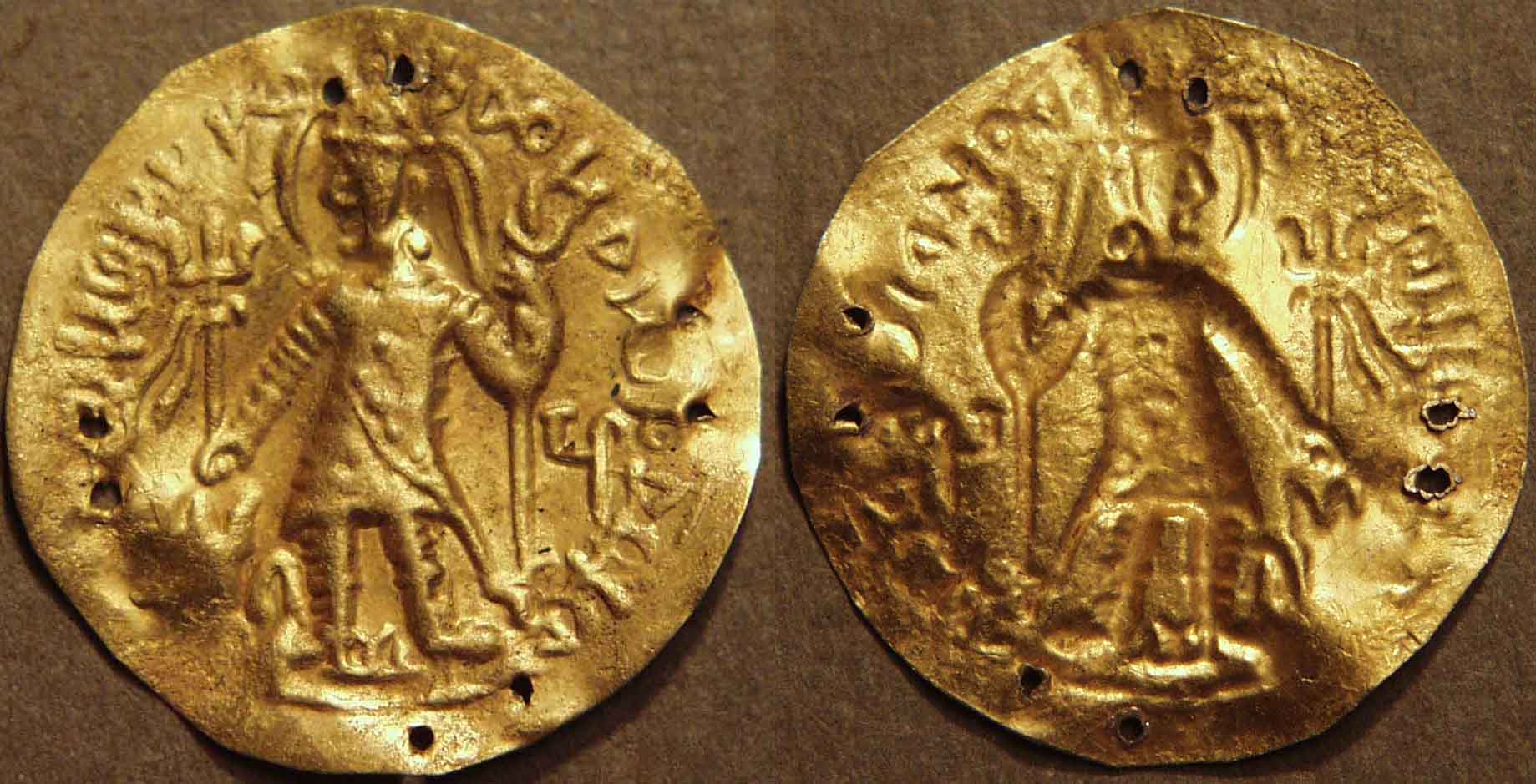
|
Gold bracteate c. 227-247 CE
Weight: 0.59 gm., Diam: 23 mm., Die axis: n.a.
Crowned, diademed king standing facing, holding trident and sacrificing at altar at left,
second trident above altar, Bactrian legend around: þAONANOþAO KA ... N ... ηþKO KOþANO
additional Brahmi letters: ha ra right, gho or yo between legs, ga left /
Incuse impression of obverse
Unpublished |
 |
Gold bracteates were used to decorate the funerary garments of royal burials. This piece, along with the next one, are
based on the obverse and reverse of the previous dinar, Göbl 634; they are in fine style and may have even been struck using the coin dies. Might they have been struck
for Kanishka II's own burial? It's a shame that the archaeological context in which these were found is lost for ever. For more bracteates, see the page on
Gold bracteates. |

|
Gold bracteate c. 227-247 CE
Weight: 0.55 gm., Diam: 24 mm., Die axis: n.a.
Two-armed Shiva standing facing, holding trident and diadem, Bull Nandi left behind,
Bactrian legend right: OηþO, tamgha at left /
Incuse impression of obverse
Unpublished |
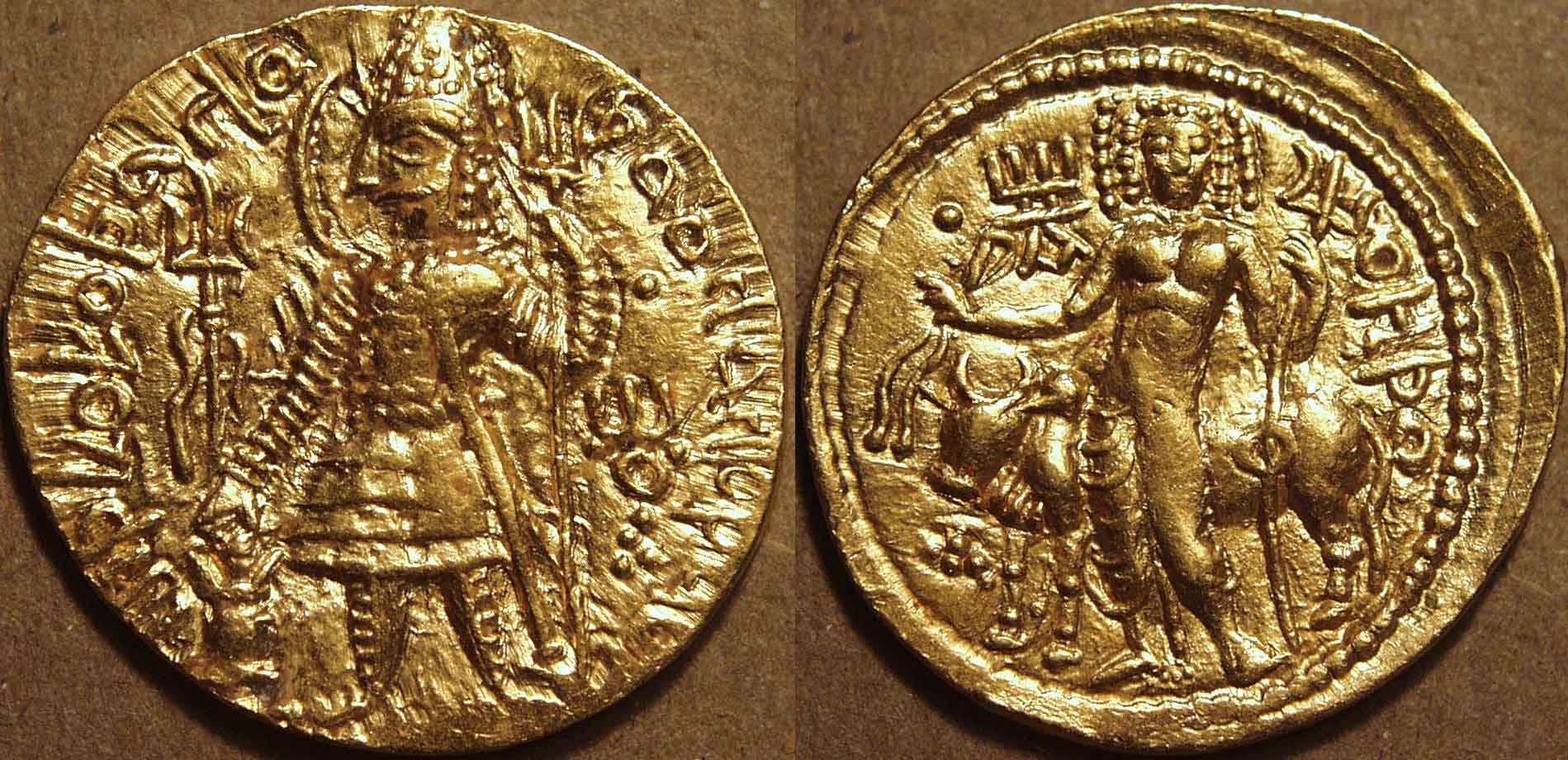
|
Gold dinar, c. 227-247 CE
Weight:8.00 gm., Diam:23 mm., Die axis:1h
King standing left, sacrificing at altar
Bactrian legend: Shaonanoshao Kanishko Koshano
( King of Kings Kanishka)/
Oesho (Shiva) standing with bull (Nandi) |
 |
This coin, previously unpublished, is important because it is of the style of Vasudeva I (Göbl 655 and 657) but the legend
clearly indicates it was issued by Kanishka II. This shows that the area where this coin was minted, perhaps Peshawar, or perhaps even further in the northwestern parts of the
kingdom, was not lost to the Kushano-Sasanians by Vasudeva, as has been long thought, but by Kanishka II. It also provides a link to the so-called "Xodeshah" coins,
suggesting that those coins were also issued by Kanishka II. |
 |
 |
 |
Copper coins |
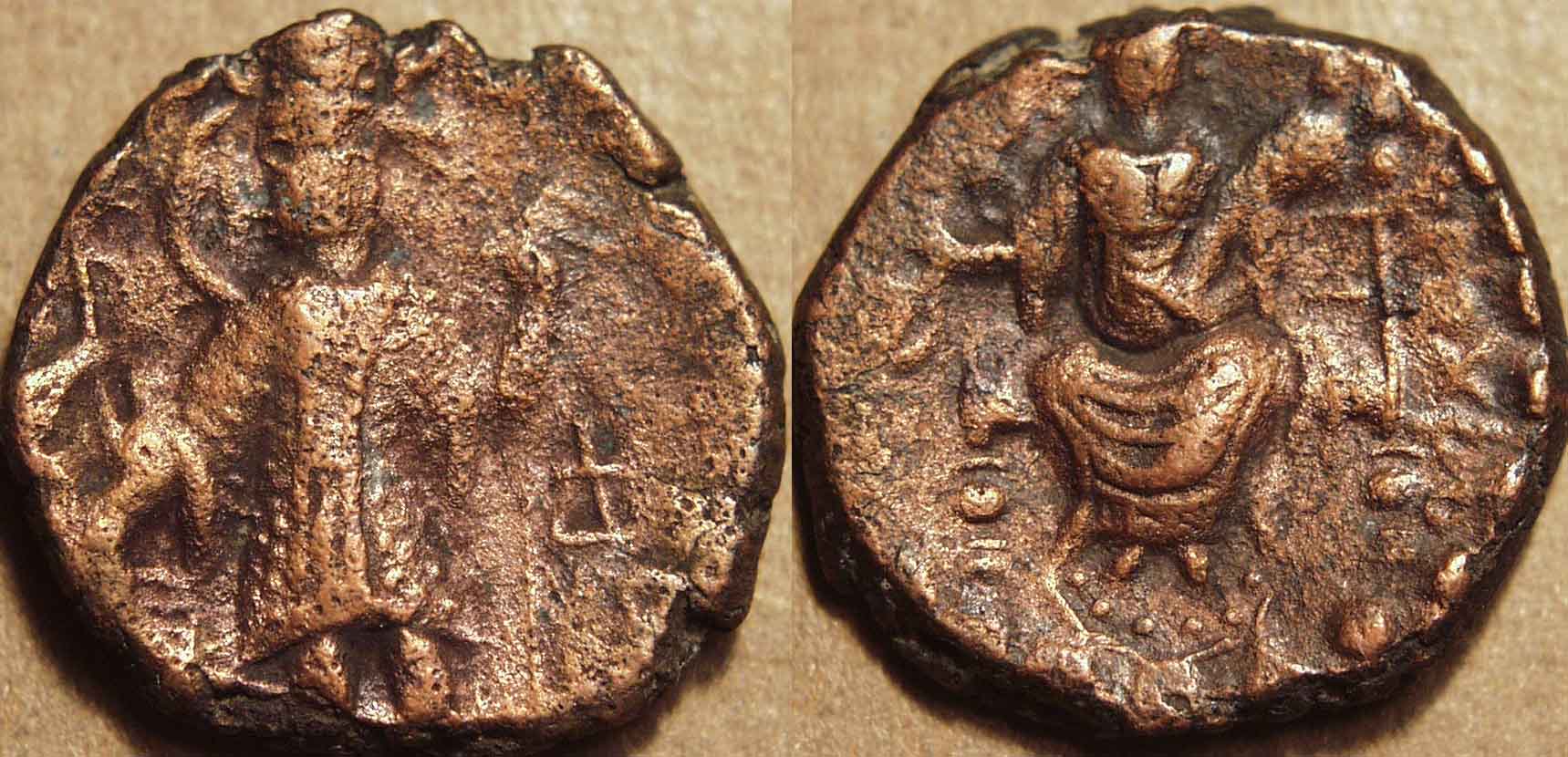
|
Copper unit, c. 227-247 CE
Weight: 6.82 gm., Diam: 20-21 mm., Die axis: 12 o'clock
Crowned, diademed king standing facing, holding standard and sacrificing at altar at left,
Brahmi letter: vi right /
Goddess of plenty Ardochsho enthroned facing, holding diadem and cornucopia,
Göbl 1015, MAC 3507-11 |
 |
The copper coins attributable to Kanishka II are done so on the basis of style and the presence of the Brahmi "monograms"
present on the coins. This coin has the Brahmi vi; the subsequent ones have respectively the pri and ha ra. |
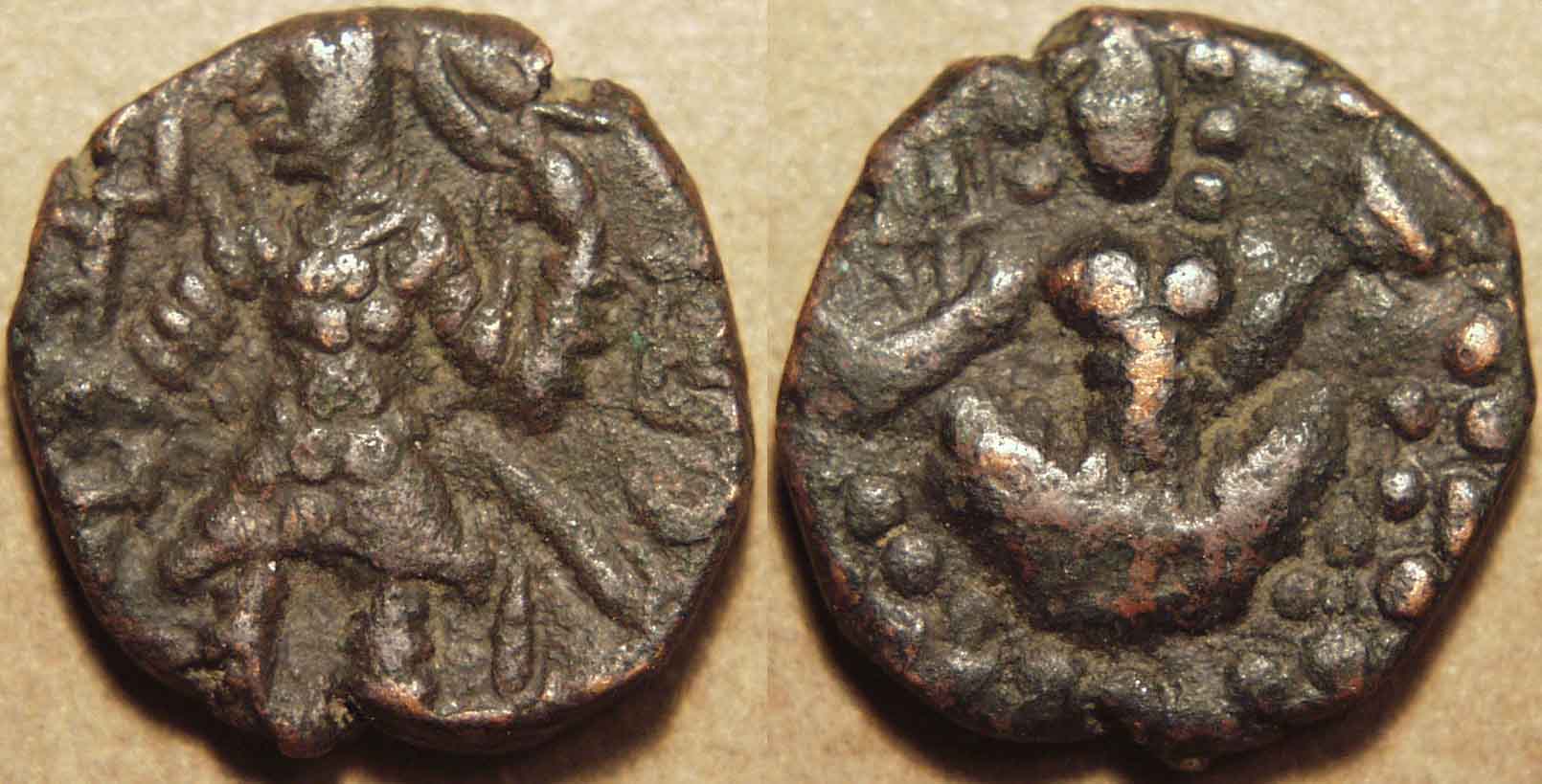
|
Copper unit, c. 227-247 CE
Weight: 5.07 gm., Diam: 17-18 mm., Die axis: 12 o'clock
Crowned, diademed king standing facing, holding standard and sacrificing at altar at left,
Brahmi letter: pri right /
Goddess of plenty Ardochsho enthroned facing, holding diadem and cornucopia,
Unpublished, hinted at in Göbl 1019 |

|
Copper unit, c. 227-247 CE
Weight: 6.18 gm., Diam: 20 mm., Die axis: 12 o'clock
Crowned, diademed king standing facing, holding standard and sacrificing at altar at left,
Brahmi letters: hara right, gho or yo between legs, ga left /
Goddess of plenty Ardochsho enthroned facing, holding diadem and cornucopia,
Göbl 1019 |
 |
Some have read the Brahmi "monogram" on this coin as hu rather than ha ra. However, this coin shows
conclusively that it should be read as ha ra because the letter forms are identical to those on the rare copper coins of Gadahara, where the reading is obvious from the
context. |
|
|